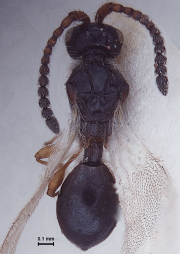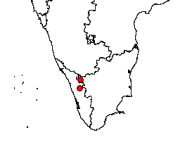 Fig 1. Female, dorsal view |
 Fig 2. Female in profile |
 Fig 3. Antenna (Female) |
|
 Fig 4. Forewing |
 Fig 5. Hind wing |
 Fig 6. Mesosoma, dorsal view |
 Fig 7. Distribution map |
|
Nomenclature
Aneuropria Kieffer, 1905: 9. Type species Aneuropria clavata Kieffer.
Pezopria Kieffer, 1911:88. Synonymized by Masner and Sudholm, 1959.
Diagnosis
Small sized, body robust, around 1.5mm long. Head and body usually black, with appendages lighter in colour. Body smooth and shining, lacking micropilosity, but with sparse long semierect hairs, never with foam-like structures. Hairy cushion dense on post gena, sides of pronotum and upper part of propleuron.
Head subglobular, transverse dorsally. Antennal shelf often well developed. Head without any armature. Mandibles normal, bidentate, not beak-like. Eyes with sparse pilosity. Antennae 12-segmented in females and 14-segmented in males. Female antennae clothed with fine pubescence and with a non-abrupt clava, segments gradually incrassate towards tip, A12 distinctly longest and more than 1.5x as long as A11. Malar sulcus not distinct. Malar space and temples distinctly longer than eye length. Occipital flange step-like.
Cervix distinct. Pronotal shoulders often curved and not angulate at sides. Mesoscutum with distinct notauli, strongly diverging in front. Humeral sulcus absent. Anterior scutellar pit bifoveate. Lateral and posterior scutellar pits present. Sternaulus usually present. Metapleuron and propodeum densely hairy. Dorsellum medially with three distinct keels, propodeum sometimes elongate, with a distinct median and a pair of lateral carinae or keels (plicae). Wings fully developed, venation very much reduced, only with an incomplete submarginal vein, not reaching basal one-fourth of wing length, at times with a white hairless streak on median forewing. Hindwings with submarginal vein complete.
Petiole always longer than wide, usually with longitudinal striae. Anterior margin of T2/large tergite emerging above level of petiole and with or without a median furrow or emargination. Metasoma elongate, basal tergites extremely short and compressed under large tergite.
Geographic Distribution
For the distribution of the genus in India, see Fig.7.
Species known from India
1. Aneuropria kairali Rajmohana & Narendran
2. Aneuropria nilgiriensis Sharma
Remarks
Not commonly represented in collections. The following characters serve to distinguish the genus from other genera like Trichopria Ashmead and Basalys Westwood of Diapriinae with 12 and 14 segmented antennae in females and males, respectively.
• Short robust body, mandibles usually normal, bidentate.
• Antenna 12 segmented, without an abrupt clava in females, 14 segmented in males.
• Notauli distinct.
• Anterior scutellar grooves paired.
• Forewings comparatively broad, with reduced venation, with just an incomplete submarginal vein.
• T2 with or without a median emargination and occupying almost the whole of dorsum.
The New World forms have opisthognathous mouthparts (Masner and Garcia, 2002).
References
Kieffer, J. J. 1905. Nouveaux Proctotrypides exotiques conserves au Musee Civique de Genes. Annali del Museo Civico di Storia Naturale Giacomo Doria (Genova), 2(2): 9-39.
Kieffer, J. J. 1911. Species des Hyménoptères d'Europe et d'Algérie. Vol. 10. Pages 753-912. Librarie Scientifique A. Hermann & Fils, Paris. Pp.
Masner, L, and Sundholm, A. 1959. Some nomenclatoric problems in Diapriidae (Hym., Proctotrupoidea) Cˇ asopis Cˇ eske´ Spolecˇnosti Entomologicke´ 56: 161-168.
Masner, L and Garcia, J.L. 2002. The genera of Diapriinae (Hymenoptera: Diapriidae) in the New World. Bulletin of the American Museum of Natural History, 268: 1-138.
Rajmohana, K and Bijoy, C., 2012. A checklist of Diapriidae and Proctotrupidae (Hymenoptera: Insecta) from India.
|